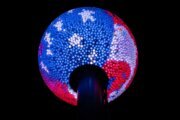The premier of Victoria plunged the region into a “state of disaster” on Sunday, announcing even stricter lockdown measures, introducing a nightly curfew and banning virtually all trips outdoors after Australia’s second largest state recorded 671 new infections in a single day.
Daniel Andrews told Victorians at a news conference that “we have to do more, and we have to do more right now,” as the state battles to contain a devastating coronavirus outbreak that had already stripped residents of their freedoms, livelihoods and social interactions and made it an outlier from the rest of the country.
“Where you slept last night is where you’ll need to stay for the next six weeks,” Andrews said, announcing a curfew between 8 p.m. and 5 a.m. beginning Sunday evening and moving Metropolitan Melbourne into stage four lockdown measures.
In that part of the state, only one person per household will be allowed to leave their homes once a day — outside of curfew hours — to pick up essential goods, and they must stay within a 5 kilometer radius of their home. Melburnians had already been under strict measures for most of July after the area was identified as the epicenter of Australia’s second wave.
The draconian new rules were spurred by more bleak Covid-19 figures. Seven new deaths were announced on Saturday, bringing the state’s total to 123, and there have been 11,557 confirmed infections.
In addition, Andrews said the state has 760 “mystery cases,” where “we cannot trace back the source of that person’s infection.”
“Those mysteries and that community transmission is in many respects our biggest challenge and the reason why we need to move to a different set of rules,” Andrews said. “The whole way through this, I promised to be upfront. So I’ll say this now. This will be imperfect. And for a little while, there’ll be more questions than answers,” he added of the swath of new measures.
The announcement caps an intensely difficult year for the state; Victoria last used its state of disaster distinction when bushfires were tearing through much of the region at the turn of the year. Andrews accepted that residents “will feel scared and sad and worried,” but told them: “We are Victorians — and we will get through this as Victorians. With grit, with guts and together.”
“I’ve had the job of leading this state for almost six years — more than 2,000 days,” Andrews said. “And today is by far the hardest day — and the hardest decision.”
He noted that there will be “common-sense exceptions” to the lockdown rules, such as if a person’s nearest supermarket is further than five kilometers away or if a parents needs to take young children with them when they go for a walk.
Exercise can be taken for up to an hour a day, with one other person, but still within five kilometers of a person’s home. All of the restrictions can be relaxed for “work, medical care or compassionate reasons.”
Patrolling police officers have been a frequent sight in Melbourne, a city of 5 million, in recent weeks — as authorities seek to enforce rules on leaving home and on the mandatory wearing of face masks.
Outside of Metropolitan Melbourne, regional Victoria will be placed under stage three restrictions starting at midnight on Wednesday meaning cafes, bars and restaurants must be closed. All schools in Victoria will also move back to online learning.”
All new restrictions will be in effect for six weeks from the date they are imposed.
The state has been battered by the coronavirus pandemic far more severely than the rest of Australia in recent weeks, but other officials are on alert as they hope to prevent a second wave in their states.
In New South Wales, Premier Gladys Berejiklian on Sunday “strongly recommended” that people wear masks in enclosed spaces where there is no social-distancing, at places of worship, and in areas with high community transmission. The state recorded 12 new cases on Sunday.





